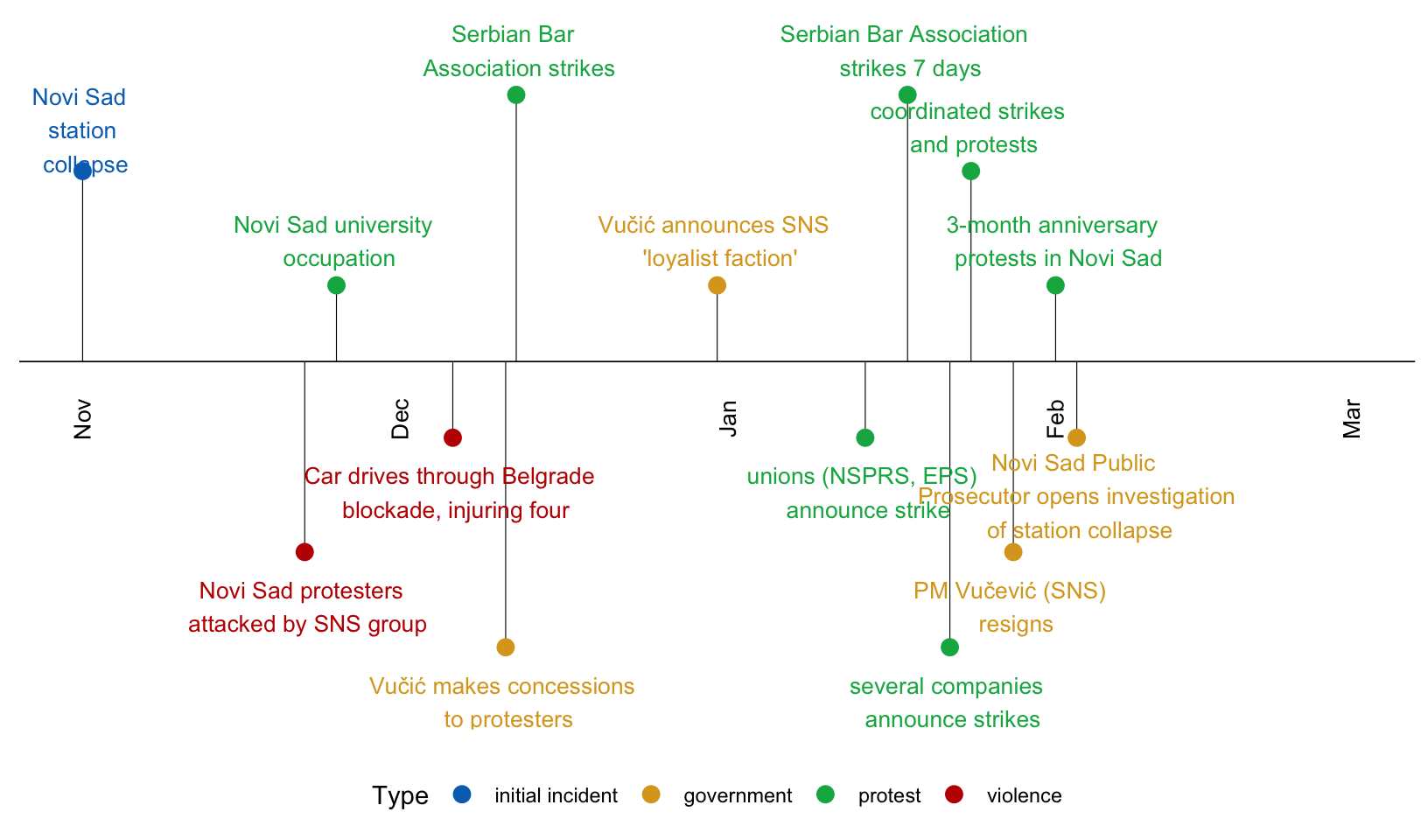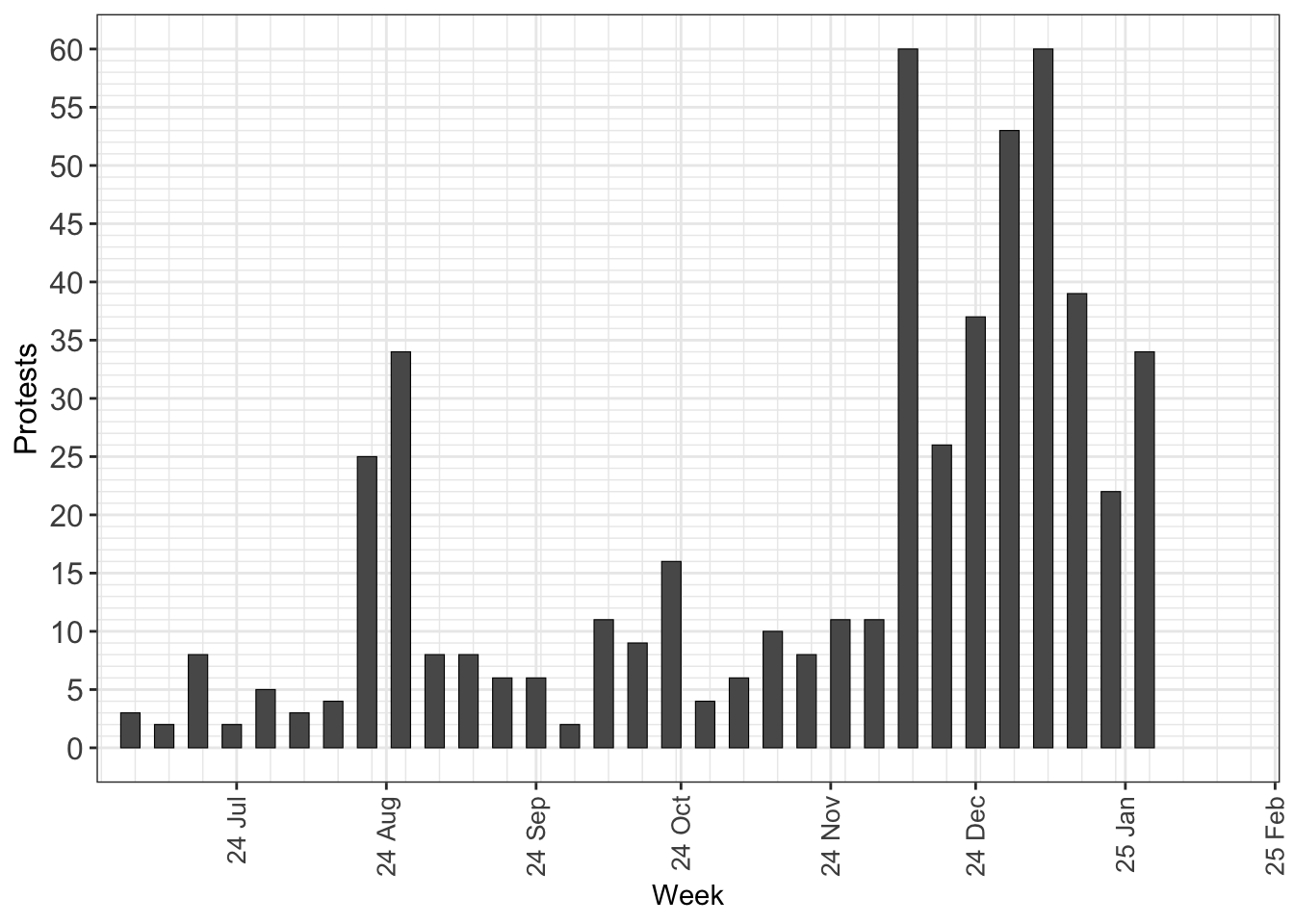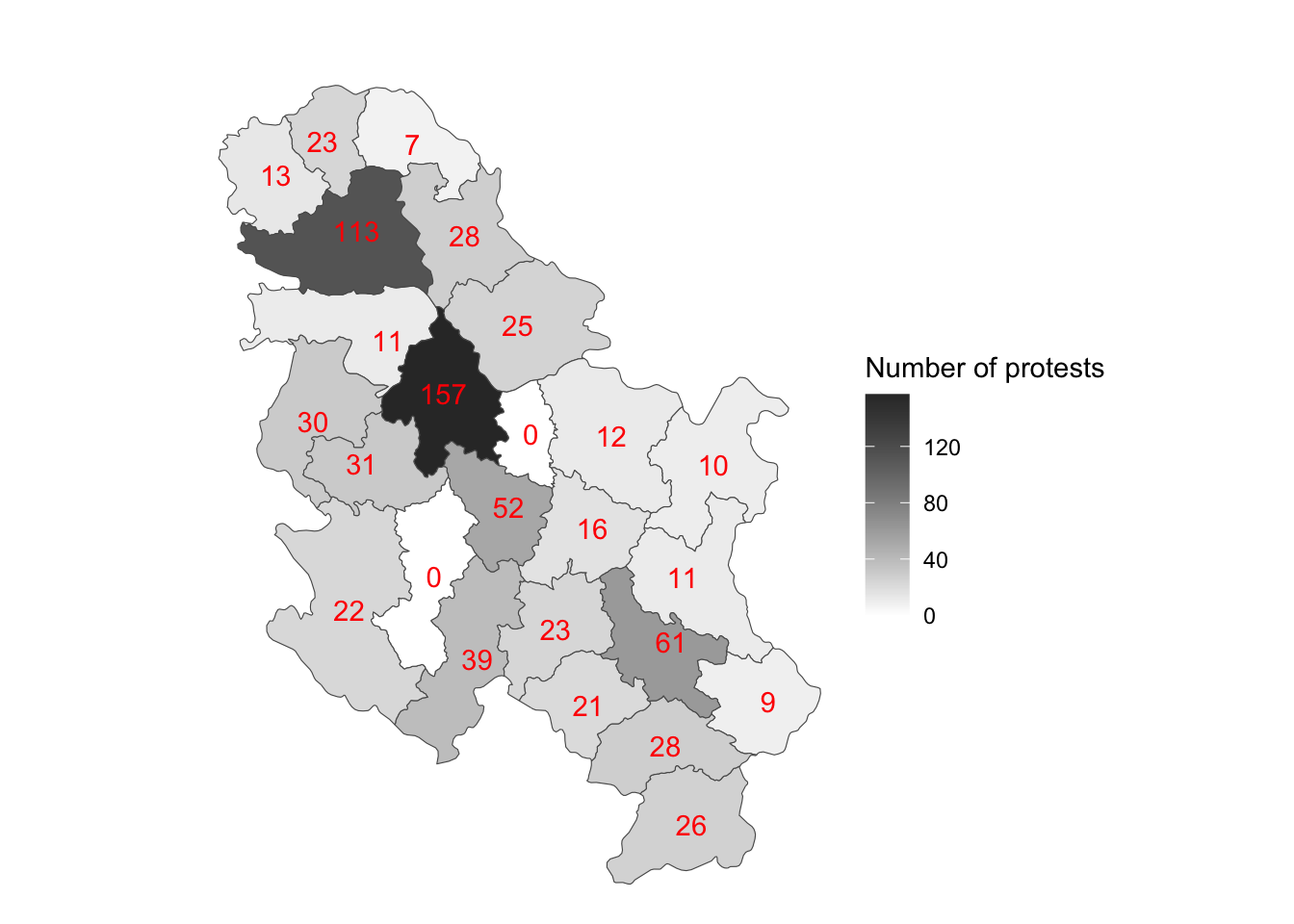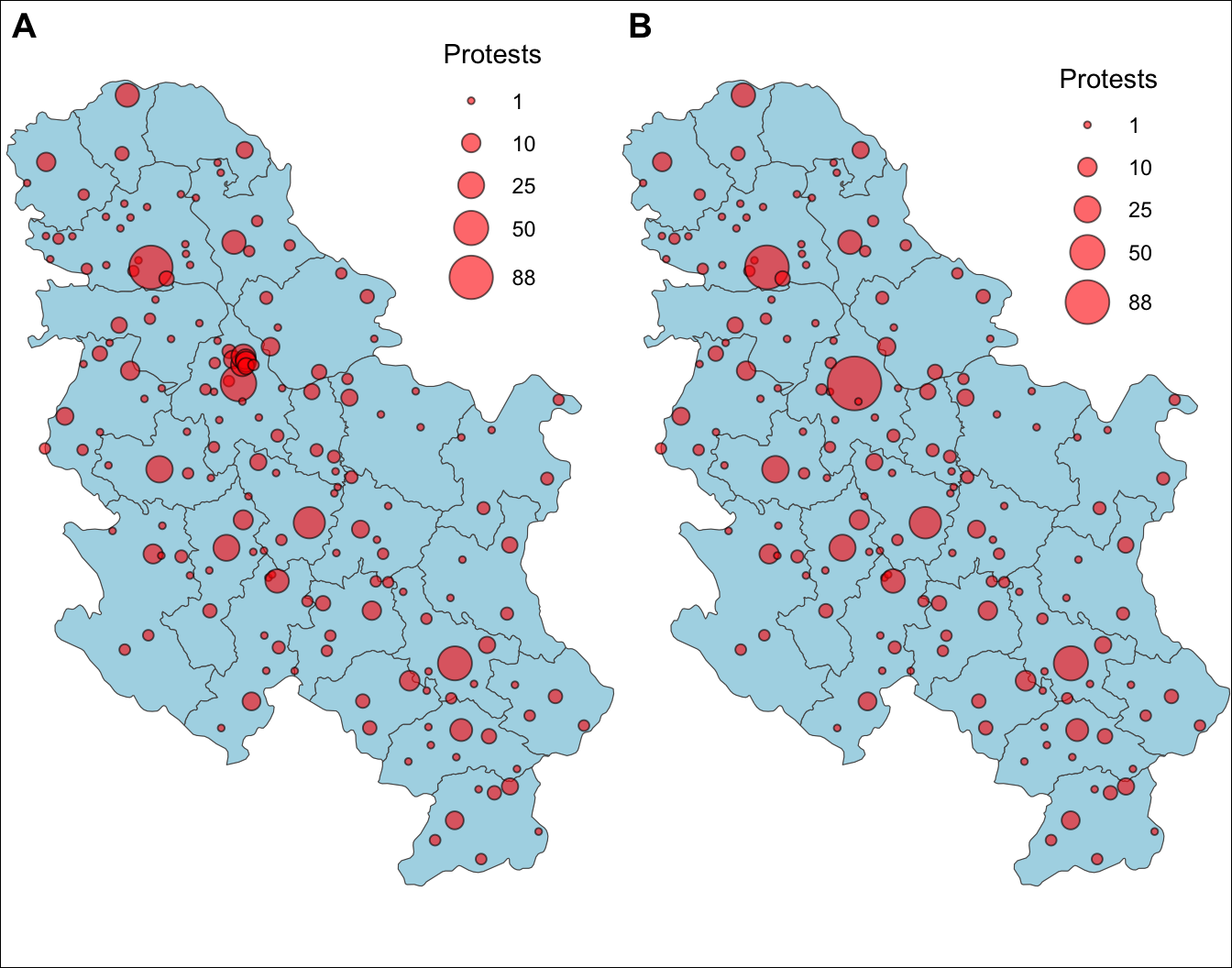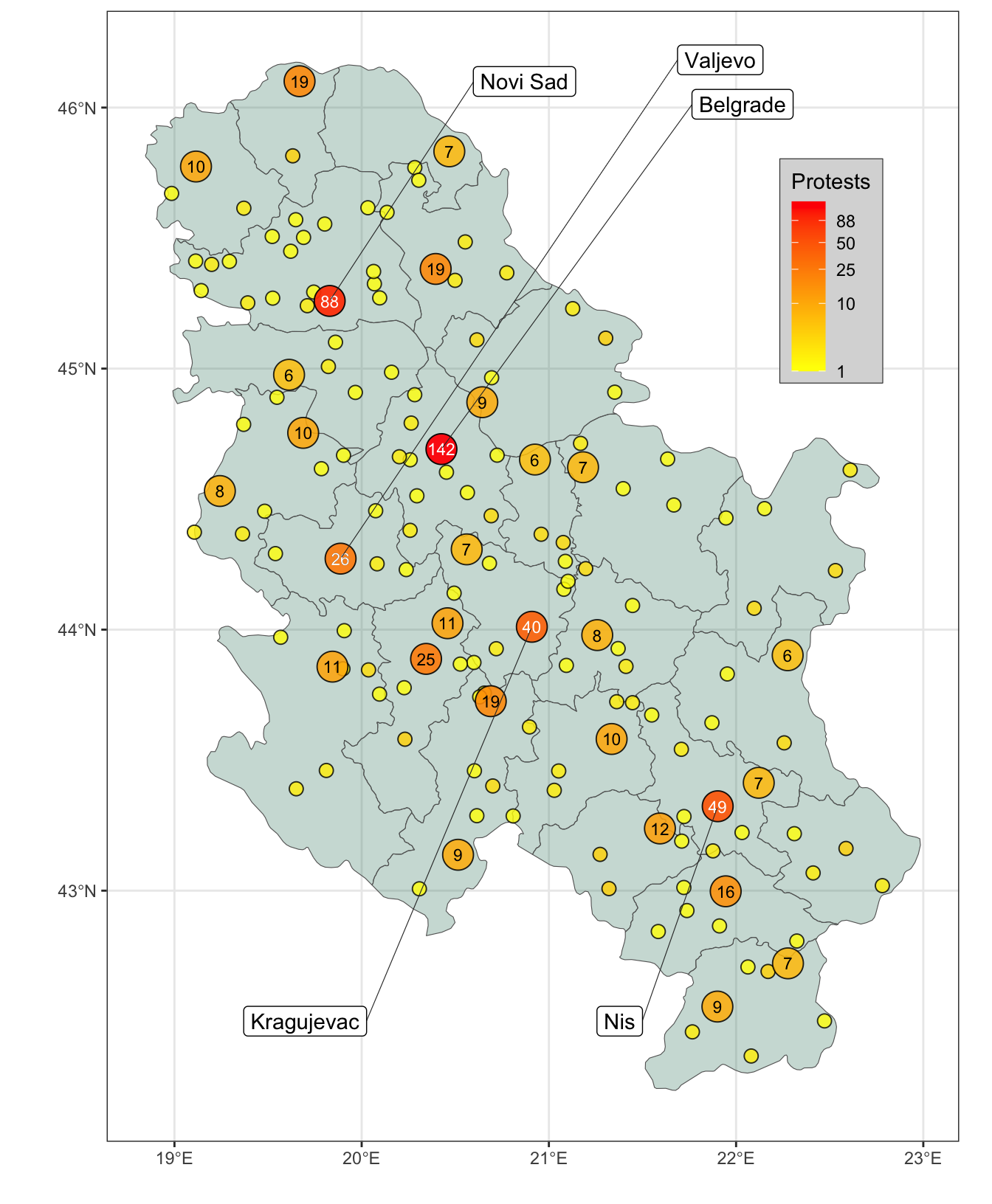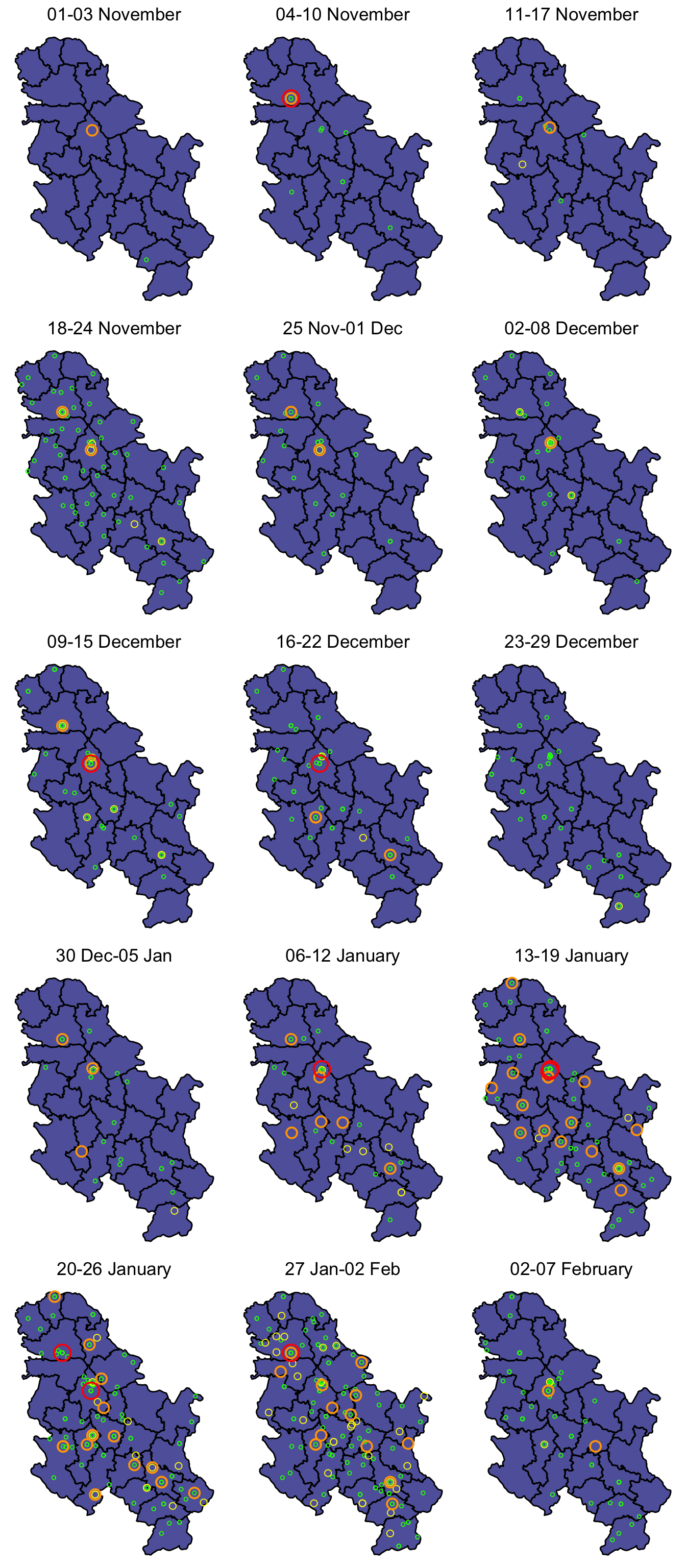--- title: Serbia anti-corruption protests date: 2025-02-01 description: "Data on Serbia anti-corruption protests." image: srb_protests.png twitter-card: image: "srb_protests.png" open-graph: image: "srb_protests.png" categories: - social movements - counter-mobilisation --- [ protests ](https://apnews.com/article/serbia-roof-collapse-china-protests-3cfa282938b1ddec12c4795b9ecb3e95) . Since the Serbian Progressive Party (*Srpska napredna stranka*, SNS) has led the Serbian government since 2012 (under President Aleksandar Vučić since 2017), protests inevitably focused on Vučić and the SNS, decrying their culpability for such public infrastructure failures.```{r data-setup, echo=FALSE, message=FALSE, warning=FALSE} library(tidyverse) library(tidygeocoder) library(ggplot2) library(sf) library(rnaturalearth) library(mapview) library(dplyr) library(spatstat) library(leafpop) library(readxl) # SRB <- read_csv("2024-06-01-2025-01-17-Europe-Serbia.csv") SRB <- read_csv("2024-06-01-2025-02-10-Serbia.csv") ## WRANGLE DATE SRB$date <- as.Date(SRB$event_date, "%d %B %Y") ## FIX PLACES # fullANPI_long$Place=ifelse(fullANPI_long$Place=="Emilia - Romagna", # "Emilia-Romagna", fullANPI_long$Place) ``` ```{r timeline, echo=FALSE, message=FALSE, warning=FALSE, fig.cap="Timeline of events related to the protests.", fig.width=8.5} #| label: fig-timeline ## https://www.themillerlab.io/posts/timelines_in_r/ library(lubridate) library(ggplot2) library(scales) library(tidyverse) library(knitr) # library(timevis) a1 <- c("2024-11-01","-","Novi Sad \n station \n collapse") a2 <- c("2024-11-22","violence","Novi Sad protesters \n attacked by SNS group") a3 <- c("2024-11-25","protest","Novi Sad university \n occupation") a4 <- c("2024-12-06","violence", "Car drives through Belgrade \n blockade, injuring four") a5 <- c("2024-12-12", "protest", "Serbian Bar \n Association strikes") a6 <- c("2024-12-11", "government", "Vučić makes concessions \n to protesters") a7 <- c("2024-12-31", "government", "Vučić announces SNS \n 'loyalist faction'") a8 <- c("2025-01-14", "protest", "unions (NSPRS, EPS) \n announce strike") a9 <- c("2025-01-18", "protest", "Serbian Bar Association \n strikes 7 days") a10<- c("2025-01-22", "protest", "several companies \n announce strikes") a11<- c("2025-01-24", "protest", "coordinated strikes \n and protests") a12<- c("2025-01-28", "government", "PM Vučević (SNS) \n resigns") a13<- c("2025-02-01", "protest", "3-month anniversary \n protests in Novi Sad") a14<- c("2025-02-03", "government", "Novi Sad Public \n Prosecutor opens investigation \n of station collapse") SRB_timeline<-as.data.frame(rbind(a1,a2,a3,a4,a5,a6,a7,a8,a9,a10, a11,a12,a13,a14)) colnames(SRB_timeline) <- c("Date","Type","Event") # rownames(papers) <- papers$Works # papers <- dplyr::select(papers, -Works) SRB_timeline$Date <- as.Date(SRB_timeline$Date) event_type_levels <- c("initial incident", "government", "protest", "violence") event_type_colors <- c("#0070C0", "goldenrod", "#00B050", "#C00000") SRB_timelineX <- SRB_timeline$Event # Make the Event_type vector a factor using the levels SRB_timeline$Event <- factor(SRB_timeline$Event, levels=event_type_levels, ordered=TRUE) SRB_timeline$Event <- SRB_timelineX ## vary the height or direction on the timeline milestones to avoid overlapping or overcrowded text descriptions. ## Set the heights for milestones. positions <- c(0.5, -0.5, 0.2, -0.2, 0.7, -0.75, 0.2, -0.2, 0.7, -0.75) #, 1.0, -1.0) # , 0.25, -0.25, 0.75, -0.75) # Set the directions for milestones, for example above and below. directions <- c(1, -1) # Assign the positions & directions to each date from those set above. line_pos <- data.frame( "Date"=unique(SRB_timeline$Date), "position"=rep(positions, length.out=length(unique(SRB_timeline$Date))), "direction"=rep(directions, length.out=length(unique(SRB_timeline$Date)))) # Create columns with the specified positions and directions for each milestone event SRB_timeline <- merge(x=SRB_timeline, y=line_pos, by="Date", all = TRUE) # Create a one month "buffer" at the start and end of the timeline month_buffer <- 1 month_date_range <- seq(min(SRB_timeline$Date) - (months(month_buffer)-months(month_buffer)), max(SRB_timeline$Date) + (months(month_buffer)), by='month') ## 3 letter abbreviations of each month. month_format <- format(month_date_range, '%b') month_df <- data.frame(month_date_range, month_format) year_date_range <- seq(min(SRB_timeline$Date) - months(month_buffer), max(SRB_timeline$Date) + months(month_buffer), by='year') # only show the years for a december to january transition. year_date_range <- as.Date( intersect( ceiling_date(year_date_range, unit="year"), floor_date(year_date_range, unit="year")), origin = "2024-11-01") # We want the format to be in the four digit format for years. year_format <- format(year_date_range, '%Y') year_df <- data.frame(year_date_range, year_format) # Lets offset the labels 0.2 away from scatter points text_offset <- 0.13 # Let's use the absolute value since we want to add the text_offset and increase space away from the scatter points absolute_value<-(abs(SRB_timeline$position)) text_position<- absolute_value + text_offset # Let's keep the direction above or below for the labels to match the scatter points SRB_timeline$text_position<- text_position * SRB_timeline$direction # Create timeline coordinates with an x and y axis timeline_plot<-ggplot(SRB_timeline, aes(x=Date,y=position,col=Type,label=SRB_timeline$Event))+ # Add the label Milestones labs(col="Type")+ # Assigning the colors and order to the milestones scale_color_manual(values=event_type_colors, labels=event_type_levels, drop=F)+ # Using the classic theme to remove background gray theme_classic()+ # Plot a horizontal line at y=0 for the timeline geom_hline(yintercept=0, color="black", size=0.3)+ # plot the vertical lines for milestones geom_segment(data=SRB_timeline, aes(y=SRB_timeline$position,yend=0,xend=SRB_timeline$Date), color='black', size=0.2)+ # plot the scatter points at the tips of the vertical lines and date geom_point(aes(y=SRB_timeline$position), size=3)+ # remove axis since this is a horizontal timeline; postion legend to bottom theme(axis.line.y=element_blank(), axis.text.y=element_blank(), axis.title.x=element_blank(), axis.title.y=element_blank(), axis.ticks.y=element_blank(), axis.text.x =element_blank(), axis.ticks.x =element_blank(), axis.line.x =element_blank(), legend.position = "bottom")+ # add the text for each month geom_text(data=month_df, aes(x=month_date_range,y=-0.15,label=month_format), size=3.5,vjust=0.5, color='black', angle=90)+ # add the text for each year geom_text(data=year_df, aes(x=year_date_range,y=-0.25,label=year_format, fontface="bold"), size=3.5, color='black')+ # add text for points geom_text(aes(y=SRB_timeline$text_position,label=SRB_timeline$Event), size=3.5, vjust=0.6) timeline_plot ``` ```{r time-bar, message = FALSE, warning=FALSE, echo=FALSE, fig.cap="Number of protests by week."} #| label: fig-time-bar library(lubridate) demos_grouped <- SRB %>% group_by(date) %>% summarise(Protests = n()) ### GROUP BY WEEK demos_grouped_week <- demos_grouped %>% group_by(week=floor_date(date, "1 week)")) %>% summarise(ProtestsNumber = sum(Protests)) plot_demos_week <- ggplot(demos_grouped_week, aes(x=week, y=ProtestsNumber))+ geom_bar(colour="black", width=4, linewidth=0.2,stat = "identity") + theme_bw() + scale_x_date("Week",date_labels="%y %b",date_breaks="1 month",minor_breaks="1 week", limits = c(min(demos_grouped_week$week), max(demos_grouped_week$week)), expand=c(0,0))+ scale_y_continuous("Protests", breaks=seq(0,60,5), minor_breaks=seq(0,60,1), limits=c(0,60))+ theme(axis.text.x = element_text(angle = 90, vjust = 0.5, hjust=1, size=10), axis.text.y = element_text(size = 12), axis.title.y = element_text(size = 12), # legend.text=element_text(size=12), # legend.title=element_blank(), # legend.position = c(0.25, 0.8), # legend.background = element_rect(linetype = 1, linewidth = 0.5, colour = 1) ) # ggtitle("Target status")+ # theme(plot.title=element_text(hjust=1, # family='', # face='bold', # colour='black', # size=25, margin=margin(t=40,b=-30))) plot_demos_week ### GROUP BY MONTH demos_grouped_month <- demos_grouped %>% group_by(month=floor_date(date, "1 month)")) %>% summarise(ProtestsNumber = sum(Protests)) ## something's wrong here plot_demos_month <- ggplot(demos_grouped_month, aes(x=month, y=ProtestsNumber))+ geom_bar(colour="black", width=4, linewidth=0.2,stat = "identity") + theme_bw() + scale_x_date("Month",date_labels="%y %b",date_breaks="1 month",minor_breaks="1 month", limits = c(min(demos_grouped_month$month), max(demos_grouped_month$month)), expand=c(0.3,0.3))+ scale_y_continuous("Protests", breaks=seq(0,200,10), minor_breaks=seq(0,200,5), limits=c(0,200))+ theme(axis.text.x = element_text(angle = 90, vjust = 0.5, hjust=1, size=10), axis.text.y = element_text(size = 12), axis.title.y = element_text(size = 12)) # plot_demos_month ``` ```{r fig.cap="Density map of protests.", message=FALSE, warning=FALSE} #| label: fig-map-density #| include: false SRB <- as.data.frame(SRB) SRB$Latitude <- SRB$latitude SRB$Longitude <- SRB$longitude SRB$latitudeJIT <- jitter(SRB$latitude, factor = 100) SRB$longitudeJIT <- jitter(SRB$longitude, factor = 100) SRB <- subset(SRB, date > as.Date('2024-11-01')) SRB_sf <- SRB %>% st_as_sf( coords = c("longitude", "latitude"), crs = st_crs("EPSG:8682") # CRS for Serbia (https://epsg.io/?q=Serbia) ) rs = ne_countries(scale=50, returnclass="sf") |> filter(admin=="Republic of Serbia") RS = ne_states(returnclass = "sf") |> filter(admin == "Republic of Serbia") # plot(st_geometry(RS), border = 'red') # plot(st_geometry(SRB_sf), add = TRUE, cex = .5) # RS <- dplyr::select(RS, name, geometry) # RS_prov <- RS %>% dplyr::select(province = name, region, geometry) st_crs(SRB_sf) <- st_crs(rs) SRB_sf_add <- SRB_sf %>% sf::st_intersection(RS) pp = st_geometry(SRB_sf_add) window = st_geometry(rs) crs = st_crs("EPSG:8682") # CRS for Serbia pp = st_transform(pp, crs)[!st_is_empty(pp)] window = st_transform(window, crs) wt = as.ppp(c(window, pp)) # Smooth points density_spatstat <- density(wt, dimyx = 500) # Convert density_spatstat into a stars object. density_stars <- stars::st_as_stars(density_spatstat) # Convert density_stars into an sf object density_sf <- st_as_sf(density_stars) %>% st_set_crs(8682) map_density <- ggplot() + geom_sf(data = density_sf, aes(fill = v), col = NA) + scale_fill_viridis_c(option = "magma") + # scale_fill_gradientn(colours = c("grey80", "grey10")) + # geom_sf(data = st_boundary(it_states)) + theme_void() + theme(legend.position="none") map_density ``` [ ACLED ](https://acleddata.com/) (the **Armed Conflict Location and Event Data** Project) allows us to inspect this protest wave in greater detail. The spatial patterns of these protests have been marked by a strong presence in urban areas, with protesters often gathering in front of government buildings, universities, and other public institutions. The cities of Belgrade and Novi Sad (where the rail station roof collapse occurred) have seen the most frequent protest activity. @fig-map-regions and @fig-map-vanbaalen show that (unsurprisingly) the capital of Belgrade has seen the highest concentration of protest activity; thousands of protesters have gathered in front of the Serbian state TV building and other government institutions to demand unbiased reporting and accountability from the government. Novi Sad, the city where the railway station roof collapse occurred, has also seen significant protests, with demonstrators holding daily 15-minute traffic blockades to honour the 15 people who died in the tragedy. ```{r map-regions, echo=FALSE, message = FALSE, warning=FALSE, fig.cap="Map of protests by region."} #| label: fig-map-regions SRB_loc <- SRB_sf_add %>% group_by(admin1) %>% summarise(Protests=n()) SRB_loc$TOT <- sum(SRB_loc$Protests) SRB_loc$PROP <- SRB_loc$Protests / SRB_loc$TOT SRB_loc$PERCENT <- SRB_loc$PROP*100 RS = ne_states(returnclass = "sf") |> filter(admin == "Republic of Serbia") # RS_prov <- RS %>% dplyr::select(province = name, region, geometry) SRB_loc$admin1 <- case_when( SRB_loc$admin1=="Belgrade" ~ "Belgrade", SRB_loc$admin1=="Bor" ~ "Bor", SRB_loc$admin1=="Branicevo" ~ "Braničevo", SRB_loc$admin1=="Central Banat" ~ "Central Banat", SRB_loc$admin1=="Jablanica" ~ "Jablanica", SRB_loc$admin1=="Kolubara" ~ "Kolubara", SRB_loc$admin1=="Macva" ~ "Mačva", SRB_loc$admin1=="Moravica" ~ "Moravica", # Moravica|Morava SRB_loc$admin1=="Nisava" ~ "Nišava", SRB_loc$admin1=="North Backa" ~ "North Bačka", SRB_loc$admin1=="North Banat" ~ "North Banat", SRB_loc$admin1=="Pcinja" ~ "Pčinja", SRB_loc$admin1=="Pirot" ~ "Pirot", SRB_loc$admin1=="Podunavlje" ~ "Podunavlje", # Podunavlje|Danube SRB_loc$admin1=="Pomoravlje" ~ "Pomoravlje", SRB_loc$admin1=="Rasina" ~ "Rasina", SRB_loc$admin1=="Raska" ~ "Raška", SRB_loc$admin1=="South Backa" ~ "South Bačka", SRB_loc$admin1=="South Banat" ~ "South Banat", SRB_loc$admin1=="Srem" ~ "Srem", SRB_loc$admin1=="Sumadija" ~ "Šumadija", SRB_loc$admin1=="Toplica" ~ "Toplica", SRB_loc$admin1=="West Backa" ~ "West Bačka", SRB_loc$admin1=="Zajecar" ~ "Zaječar", SRB_loc$admin1=="Zlatibor" ~ "Zlatibor", ) SRB_loc <- as.data.frame(SRB_loc) mappedSRB_loc <- RS %>% left_join(SRB_loc, by = c("name_alt" = "admin1")) mappedSRB_loc[is.na(mappedSRB_loc)] <- 0 SRB_protests_region <- ggplot(mappedSRB_loc) + geom_sf(aes(fill = Protests))+ geom_sf_text(aes(label=Protests), colour="red")+ # geom_sf_text(aes(label = scales::percent(PROP)))+ scale_fill_gradient("Number of protests", low = "white", high = "gray20")+ theme_void()+ # theme(legend.position = "none")+ labs(title="")+theme(plot.title = element_text(hjust = 0.5)) SRB_protests_region ``` ```{r map-vanbaalen, message = FALSE, warning=FALSE, echo=FALSE, fig.cap="Plot of protests. Plot A shows all protests by location. In Plot B, protests in different areas of Belgrade are grouped together.", fig.height=5.5} #| label: fig-map-vanbaalen # SRB_trim <- SRB %>% drop_na(longitude) SRB <- as.data.frame(SRB) SRB$Latitude <- SRB$latitude SRB$Longitude <- SRB$longitude SRB$latitudeJIT <- jitter(SRB$latitude, factor = 100) SRB$longitudeJIT <- jitter(SRB$longitude, factor = 100) SRB_sf <- SRB %>% st_as_sf( coords = c("longitude", "latitude"), crs = st_crs("EPSG:8682") # CRS for Serbia (https://epsg.io/?q=Serbia) ) rs = ne_countries(scale=50, returnclass="sf") |> filter(admin=="Republic of Serbia") RS = ne_states(returnclass = "sf") |> filter(admin == "Republic of Serbia") # plot(st_geometry(RS), border = 'red') # plot(st_geometry(SRB_sf), add = TRUE, cex = .5) # RS <- dplyr::select(RS, name, geometry) # RS_prov <- RS %>% dplyr::select(province = name, region, geometry) st_crs(SRB_sf) <- st_crs(rs) SRB_sf_add <- SRB_sf %>% sf::st_intersection(RS) SRB_loc <- SRB_sf_add %>% group_by(location) %>% summarise(Protests=n()) plot_VB_diff <- ggplot() + geom_sf(data = RS, fill = "lightblue")+ # "aquamarine" geom_sf(data = st_boundary(RS), linewidth=0.05, color=alpha("grey30", 0.7), fill="grey30", alpha=0.7)+ coord_sf(xlim = c(18.8, 23), ylim = c(42.2, 46.2), expand = FALSE)+ geom_count(data=SRB_sf, aes(x=Longitude, y=Latitude), fill="red", shape=21, alpha=0.6, color="black", stroke=0.5)+ scale_size(name = "Protests", breaks = c(1, 10, 25, 50, 88), range = c(1, 8))+ theme_void()+theme(legend.position=c(0.8, 0.88)) # SRB_loc %>% subset(str_starts(location, "Belgrad")) %>% summarise(sum(Protests)) SRB_belgrade_grouped <- SRB %>% mutate( location=ifelse(startsWith(location, "Belgrad"), "Belgrade", location) ) SRB_belgrade_grouped$latitude=ifelse( SRB_belgrade_grouped$location=="Belgrade", 44.6916, SRB_belgrade_grouped$latitude) SRB_belgrade_grouped$longitude=ifelse( SRB_belgrade_grouped$location=="Belgrade", 20.4261, SRB_belgrade_grouped$longitude) SRB_belgrade_grouped$Latitude <- SRB_belgrade_grouped$latitude SRB_belgrade_grouped$Longitude <- SRB_belgrade_grouped$longitude SRB_belgrade_grouped$latitudeJIT <- jitter(SRB_belgrade_grouped$latitude, factor = 100) SRB_belgrade_grouped$longitudeJIT <- jitter(SRB_belgrade_grouped$longitude, factor = 100) SRB_belgrade_grouped_sf <- SRB_belgrade_grouped %>% st_as_sf( coords = c("longitude", "latitude"), crs = st_crs("EPSG:8682") # CRS for Serbia (https://epsg.io/?q=Serbia) ) plot_VB_group <- ggplot() + geom_sf(data = RS, fill = "lightblue")+ geom_sf(data = st_boundary(RS), linewidth=0.05, color=alpha("grey30", 0.7), fill="grey30", alpha=0.7)+ coord_sf(xlim = c(18.8, 23), ylim = c(42.2, 46.2), expand = FALSE)+ geom_count(data=SRB_belgrade_grouped_sf, aes(x=Longitude, y=Latitude), fill="red", shape=21, alpha=0.6, color="black", stroke=0.5)+ scale_size(name = "Protests", breaks = c(1, 10, 25, 50, 88), range = c(1, 10))+ theme_void()+theme(legend.position=c(0.8, 0.85)) # theme(legend.position=c(0.9, 0.8), legend.margin=margin(6,6,6,6), # legend.background=element_rect(fill="grey85",linewidth=0.2, # linetype="solid", # colour="grey20"))+ # guides(colour=guide_legend()) library(cowplot) SRBmaps <- plot_grid(plot_VB_diff, plot_VB_group, nrow = 1, align = "h", labels = c('A', 'B'))+ theme(plot.background=element_rect(color = "black")) SRBmaps ``` ```{r map-hellmeier, message = FALSE, warning=FALSE, echo=FALSE, fig.cap="Plot of protests, similar to the map in Hellmeier (2022).", fig.height=8.5} #| label: fig-map-hellmeier SRB_belgrade_grouped <- SRB %>% mutate( location=ifelse(startsWith(location, "Belgrad"), "Belgrade", location) ) SRB_belgrade_grouped$latitude=ifelse( SRB_belgrade_grouped$location=="Belgrade", 44.6916, SRB_belgrade_grouped$latitude) SRB_belgrade_grouped$longitude=ifelse( SRB_belgrade_grouped$location=="Belgrade", 20.4261, SRB_belgrade_grouped$longitude) SRB_belgrade_grouped$Latitude <- SRB_belgrade_grouped$latitude SRB_belgrade_grouped$Longitude <- SRB_belgrade_grouped$longitude SRB_belgrade_grouped$latitudeJIT <- jitter(SRB_belgrade_grouped$latitude, factor = 100) SRB_belgrade_grouped$longitudeJIT <- jitter(SRB_belgrade_grouped$longitude, factor = 100) SRB_belgrade_grouped_sf <- SRB_belgrade_grouped %>% st_as_sf( coords = c("longitude", "latitude"), crs = st_crs("EPSG:8682") # CRS for Serbia (https://epsg.io/?q=Serbia) ) st_crs(SRB_belgrade_grouped_sf) <- st_crs(rs) region_points <- st_join(SRB_belgrade_grouped_sf, RS, left=TRUE) %>% #SRB_sf_add group_by(location) %>% summarise(Protests = n()) %>% arrange(Protests) %>% st_as_sf(., coords = c("Longitude", "Latitude")) %>% st_set_crs(., 8682) %>% # strip out the multipoints st_cast("POINT") # ## fix one NA for Belgrade # region_points[is.na(region_points)] <- "Belgrade" st_crs(region_points) <- st_crs(RS) # Create breaks for the color scale mybreaks <- c(0, 1, 10, 25, 50, 88) mylabels <- c("0", "1", "10", "25", "50", "88") ## https://ggrepel.slowkow.com/articles/examples.html library(ggrepel) ggplot()+ geom_sf(data=RS, fill="aquamarine4", alpha=0.3, lwd=.2, color="grey40")+ # plot circles in districts where demonstrations occurred geom_sf(data=region_points %>% filter(Protests<5), aes(geometry=geometry, fill=Protests, alpha=Protests), shape=21, size=3)+ geom_sf(data=region_points %>% filter(Protests>5), aes(geometry=geometry, fill=Protests, alpha=Protests), shape=21, size=7)+ # # this can plot cities/places where no Protests occurred # geom_sf(data=kreise_points %>% filter(events==0), # aes(geometry=geometry), color="black", alpha=0.5, shape=21, size=7)+ # add black text labels for number of demos (over 10) where occurred, inside circles geom_sf_text(data=region_points %>% filter(Protests>5 & Protests<29), aes(geometry=geometry, label=Protests), colour="#000000", size=3)+ # add white text labels to highlight the places where there were many demos geom_sf_text(data=region_points %>% filter(Protests>25), aes(geometry=geometry, label=Protests), colour="#FFFFFF", size=3)+ # label some of the locations # geom_label_repel(data=kreise_points %>% subset(district=="Berlin"), # aes(x=st_coordinates(geometry)[,1], # y=st_coordinates(geometry)[,2], label=district), # fill="white", # nudge_x=1.5, nudge_y=0.5, # segment.curvature = -1e-20, # segment.size = 0.2, segment.color = "grey20", seed=42)+ geom_label_repel(data=region_points %>% subset(Protests>25 & st_coordinates(geometry)[,2]>44.1), aes(x=st_coordinates(geometry)[,1], y=st_coordinates(geometry)[,2], label=location), nudge_y=46.1-st_coordinates(subset(region_points, Protests>25 & st_coordinates(geometry)[,2]>44.1))[,2], # direction="x", nudge_x=46.3-st_coordinates(subset(region_points, Protests>25 & st_coordinates(geometry)[,2]>44.1))[,2], direction="y", fill="white", # segment.curvature = -1e-20, segment.size=0.2, segment.color="grey20", seed=42)+ geom_label_repel(data=region_points %>% subset(Protests>29 & st_coordinates(geometry)[,2]<44.1), aes(x=st_coordinates(geometry)[,1], y=st_coordinates(geometry)[,2], label=location), nudge_y=42.5-st_coordinates(subset(region_points, Protests>25 & st_coordinates(geometry)[,2]<44.1))[,2], # direction="x", nudge_x=42.8-st_coordinates(subset(region_points, Protests>25 & st_coordinates(geometry)[,2]<44.1))[,2], direction="y", fill="white", # segment.curvature = -1e-20, segment.size=0.2, segment.color="grey20", seed=42)+ scale_fill_gradient(name="Protests", trans="log1p", low="yellow",high="red", # low="grey80", high="darkblue", breaks = mybreaks, labels = mylabels) + scale_alpha_continuous(name="Protests", trans="log1p", range=c(.8,.95), breaks=mybreaks, labels=mylabels, guide='none')+ theme_bw()+theme(legend.position=c(0.85, 0.77), legend.margin=margin(6,6,6,6), legend.background=element_rect(fill="grey85",linewidth=0.2, linetype="solid", colour="grey20"))+ xlab("")+ylab("")+ guides(colour=guide_legend()) ``` ```{r weeks-maps-panel, message = FALSE, warning=FALSE, echo=FALSE, fig.cap="Plot of protests since 1 November 2024. The red circles represent protests of 20,000 or more; the orange, between 1,000 and 20,000; the yellow, between 100 and 1,000; and the green, fewer than 100 participants.", fig.height=16} #| label: fig-weeks-maps-panel ### Make size categories for protests SRB_sf$tags <- gsub(".*=","",SRB_sf$tags) SRB_sf$Size <- SRB_sf$tags SRB_sf$Size = ifelse(SRB_sf$Size == "no report", 49, SRB_sf$Size) SRB_sf$Size = ifelse(SRB_sf$Size == "more than 2,000", 2001, SRB_sf$Size) SRB_sf$Size = ifelse(SRB_sf$Size == "several hundred", 401, SRB_sf$Size) SRB_sf$Size = ifelse(SRB_sf$Size == "7,500", 7500, SRB_sf$Size) SRB_sf$Size = ifelse(SRB_sf$Size == "around 2000", 2000, SRB_sf$Size) SRB_sf$Size = ifelse(SRB_sf$Size == "several tens", 51, SRB_sf$Size) # SRB_sf$Size = ifelse(SRB_sf$Size == "240", 49, SRB_sf$Size) # SRB_sf$Size = ifelse(SRB_sf$Size == "650", 49, SRB_sf$Size) SRB_sf$Size = ifelse(SRB_sf$Size == "between 5,000 and 5,500", 5250, SRB_sf$Size) # SRB_sf$Size = ifelse(SRB_sf$Size == "380", 49, SRB_sf$Size) # SRB_sf$Size = ifelse(SRB_sf$Size == "60", 49, SRB_sf$Size) # SRB_sf$Size = ifelse(SRB_sf$Size == "50", 49, SRB_sf$Size) # SRB_sf$Size = ifelse(SRB_sf$Size == "100", 49, SRB_sf$Size) SRB_sf$Size = ifelse(SRB_sf$Size == "between 1,700 and 1,800", 1750, SRB_sf$Size) # SRB_sf$Size = ifelse(SRB_sf$Size == "150", 49, SRB_sf$Size) # SRB_sf$Size = ifelse(SRB_sf$Size == "190", 49, SRB_sf$Size) SRB_sf$Size = ifelse(SRB_sf$Size == "between 3,500 and 4,000", 3750, SRB_sf$Size) SRB_sf$Size = ifelse(SRB_sf$Size == "around 30", 30, SRB_sf$Size) SRB_sf$Size = ifelse(SRB_sf$Size == "12,000", 12000, SRB_sf$Size) # SRB_sf$Size = ifelse(SRB_sf$Size == "180", 49, SRB_sf$Size) SRB_sf$Size = ifelse(SRB_sf$Size == "around 400", 400, SRB_sf$Size) # SRB_sf$Size = ifelse(SRB_sf$Size == "230", 49, SRB_sf$Size) SRB_sf$Size = ifelse(SRB_sf$Size == "2,400", 2400, SRB_sf$Size) SRB_sf$Size = ifelse(SRB_sf$Size == "1,800", 1800, SRB_sf$Size) # SRB_sf$Size = ifelse(SRB_sf$Size == "170", 49, SRB_sf$Size) SRB_sf$Size = ifelse(SRB_sf$Size == "around 2,500", 2500, SRB_sf$Size) SRB_sf$Size = ifelse(SRB_sf$Size == "1,400", 1400, SRB_sf$Size) # SRB_sf$Size = ifelse(SRB_sf$Size == "600", 49, SRB_sf$Size) SRB_sf$Size = ifelse(SRB_sf$Size == "around 300", 300, SRB_sf$Size) SRB_sf$Size = ifelse(SRB_sf$Size == "tens of thousands", 20001, SRB_sf$Size) SRB_sf$Size = ifelse(SRB_sf$Size == "several thousands", 4001, SRB_sf$Size) SRB_sf$Size = ifelse(SRB_sf$Size == "thousands", 2001, SRB_sf$Size) SRB_sf$Size = ifelse(SRB_sf$Size == "around 200", 200, SRB_sf$Size) SRB_sf$Size = ifelse(SRB_sf$Size == "2,000", 2000, SRB_sf$Size) # SRB_sf$Size = ifelse(SRB_sf$Size == "900", 49, SRB_sf$Size) SRB_sf$Size = ifelse(SRB_sf$Size == "between 130 and 140", 135, SRB_sf$Size) # SRB_sf$Size = ifelse(SRB_sf$Size == "750", 49, SRB_sf$Size) # SRB_sf$Size = ifelse(SRB_sf$Size == "90", 49, SRB_sf$Size) # SRB_sf$Size = ifelse(SRB_sf$Size == "510", 49, SRB_sf$Size) # SRB_sf$Size = ifelse(SRB_sf$Size == "470", 49, SRB_sf$Size) SRB_sf$Size = ifelse(SRB_sf$Size == "several thousand", 4001, SRB_sf$Size) SRB_sf$Size = ifelse(SRB_sf$Size == "around 700", 700, SRB_sf$Size) SRB_sf$Size = ifelse(SRB_sf$Size == "a large number", 99, SRB_sf$Size) SRB_sf$Size = ifelse(SRB_sf$Size == "four", 4, SRB_sf$Size) # SRB_sf$Size = ifelse(SRB_sf$Size == "NA", 49, SRB_sf$Size) SRB_sf$Size = ifelse(SRB_sf$Size == "large numbers", 99, SRB_sf$Size) SRB_sf$Size = ifelse(SRB_sf$Size == "15,000", 15000, SRB_sf$Size) SRB_sf$Size = ifelse(SRB_sf$Size == "4,500", 4500, SRB_sf$Size) SRB_sf$Size = ifelse(SRB_sf$Size == "6,300", 6300, SRB_sf$Size) SRB_sf$Size = ifelse(SRB_sf$Size == "large number", 99, SRB_sf$Size) SRB_sf$Size = ifelse(SRB_sf$Size == "4,200", 4200, SRB_sf$Size) # SRB_sf$Size = ifelse(SRB_sf$Size == "160", 49, SRB_sf$Size) SRB_sf$Size = ifelse(SRB_sf$Size == "between 180 and 200", 190, SRB_sf$Size) SRB_sf$Size = ifelse(SRB_sf$Size == "over 1,200", 1201, SRB_sf$Size) SRB_sf$Size = ifelse(SRB_sf$Size == "2,200", 2200, SRB_sf$Size) SRB_sf$Size = ifelse(SRB_sf$Size == "5,500", 5500, SRB_sf$Size) SRB_sf$Size = ifelse(SRB_sf$Size == "3,600", 3600, SRB_sf$Size) # SRB_sf$Size = ifelse(SRB_sf$Size == "500", 49, SRB_sf$Size) # SRB_sf$Size = ifelse(SRB_sf$Size == "140", 49, SRB_sf$Size) SRB_sf$Size = ifelse(SRB_sf$Size == "around 800", 800, SRB_sf$Size) SRB_sf$Size = ifelse(SRB_sf$Size == "between 300 and 400", 350, SRB_sf$Size) SRB_sf$Size = ifelse(SRB_sf$Size == "55,000", 55000, SRB_sf$Size) SRB_sf$Size = ifelse(SRB_sf$Size == "22,000", 22000, SRB_sf$Size) SRB_sf$Size = ifelse(SRB_sf$Size == "around 10,500", 10500, SRB_sf$Size) # SRB_sf$Size = ifelse(SRB_sf$Size == "520", 49, SRB_sf$Size) SRB_sf$Size = ifelse(SRB_sf$Size == "around 6,000", 6000, SRB_sf$Size) SRB_sf$Size = ifelse(SRB_sf$Size == "1,500", 1500, SRB_sf$Size) SRB_sf$Size = ifelse(SRB_sf$Size == "between several hundred and a thousand", 601, SRB_sf$Size) SRB_sf$Size = ifelse(SRB_sf$Size == "between 900 and 1,000", 950, SRB_sf$Size) SRB_sf$Size = ifelse(SRB_sf$Size == "around 1,200", 1200, SRB_sf$Size) SRB_sf$Size = ifelse(SRB_sf$Size == "between 1,200 and 1,300", 1250, SRB_sf$Size) SRB_sf$Size = ifelse(SRB_sf$Size == "1,250", 1250, SRB_sf$Size) SRB_sf$Size = ifelse(SRB_sf$Size == "around 1,500", 1500, SRB_sf$Size) SRB_sf$Size = ifelse(SRB_sf$Size == "between 3,600 and 3,800", 3700, SRB_sf$Size) SRB_sf$Size = ifelse(SRB_sf$Size == "1,700", 1700, SRB_sf$Size) SRB_sf$Size = ifelse(SRB_sf$Size == "between 1300 and 1400", 1350, SRB_sf$Size) SRB_sf$Size = ifelse(SRB_sf$Size == "at least 20,000", 20001, SRB_sf$Size) SRB_sf$Size = ifelse(SRB_sf$Size == "several hundreds", 401, SRB_sf$Size) SRB_sf$Size = ifelse(SRB_sf$Size == "between 5,000 and 5,200", 5100, SRB_sf$Size) SRB_sf$Size = ifelse(SRB_sf$Size == "between 6,500 and 7,000", 6750, SRB_sf$Size) SRB_sf$Size = ifelse(SRB_sf$Size == "2,600", 2600, SRB_sf$Size) SRB_sf$Size = ifelse(SRB_sf$Size == "around 3,500", 3500, SRB_sf$Size) SRB_sf$Size = ifelse(SRB_sf$Size == "around 4,000", 4000, SRB_sf$Size) SRB_sf$Size = ifelse(SRB_sf$Size == "more than thousand", 1001, SRB_sf$Size) SRB_sf$Size = ifelse(SRB_sf$Size == "around 20", 20, SRB_sf$Size) SRB_sf$Size = ifelse(SRB_sf$Size == "between 53.000 and 55.000", 54000, SRB_sf$Size) # SRB_sf$Size = ifelse(SRB_sf$Size == "6", 49, SRB_sf$Size) # SRB_sf$Size = ifelse(SRB_sf$Size == "28000", 49, SRB_sf$Size) SRB_sf$Size = ifelse(SRB_sf$Size == "between 1.700 and 1.800", 1750, SRB_sf$Size) SRB_sf$Size = ifelse(SRB_sf$Size == "between 3.500 and 4.000", 3750, SRB_sf$Size) SRB_sf$Size = ifelse(SRB_sf$Size == "between 7000 and 7200", 7100, SRB_sf$Size) SRB_sf$Size = ifelse(SRB_sf$Size == "more than 1000", 1001, SRB_sf$Size) # SRB_sf$Size = ifelse(SRB_sf$Size == "220", 49, SRB_sf$Size) SRB_sf$Size = ifelse(SRB_sf$Size == "between several tens and 400", 301, SRB_sf$Size) # SRB_sf$Size = ifelse(SRB_sf$Size == "1000", 49, SRB_sf$Size) # SRB_sf$Size = ifelse(SRB_sf$Size == "2", 49, SRB_sf$Size) SRB_sf$Size = ifelse(SRB_sf$Size == "around 170", 170, SRB_sf$Size) SRB_sf$Size = ifelse(SRB_sf$Size == "a few", 9, SRB_sf$Size) SRB_sf$Size = ifelse(SRB_sf$Size == "between 17.000 and 18.000", 17500, SRB_sf$Size) SRB_sf$Size = ifelse(SRB_sf$Size == "between 4.500 and 6.000", 5250, SRB_sf$Size) SRB_sf$Size = ifelse(SRB_sf$Size == "around 100", 100, SRB_sf$Size) SRB_sf$Size = ifelse(SRB_sf$Size == "around 50", 50, SRB_sf$Size) SRB_sf$Size = ifelse(SRB_sf$Size == "between 100.000 and 102.000", 101000, SRB_sf$Size) SRB_sf$Size = ifelse(SRB_sf$Size == "around 7.000", 7000, SRB_sf$Size) SRB_sf$Size = ifelse(SRB_sf$Size == "approximately 12", 12, SRB_sf$Size) SRB_sf$Size = ifelse(SRB_sf$Size == "around 1000", 1000, SRB_sf$Size) SRB_sf$Size = ifelse(SRB_sf$Size == "about 50", 50, SRB_sf$Size) SRB_sf$Size = ifelse(SRB_sf$Size == "several tens of thousands", 40001, SRB_sf$Size) SRB_sf$Size = ifelse(SRB_sf$Size == "more than 100", 101, SRB_sf$Size) SRB_sf$Size = ifelse(SRB_sf$Size == "more than 200", 201, SRB_sf$Size) SRB_sf$Size = ifelse(SRB_sf$Size == "around 10", 10, SRB_sf$Size) # SRB_sf$Size = ifelse(SRB_sf$Size == "330", 49, SRB_sf$Size) SRB_sf$Size = ifelse(SRB_sf$Size == "several ten", 39, SRB_sf$Size) SRB_sf$Size = ifelse(SRB_sf$Size == "at least 2200", 2201, SRB_sf$Size) SRB_sf$Size = ifelse(SRB_sf$Size == "at least 2100", 2101, SRB_sf$Size) SRB_sf$Size = ifelse(SRB_sf$Size == "no report; local administrators", 49, SRB_sf$Size) SRB_sf$Size = ifelse(SRB_sf$Size == "around 1300", 1300, SRB_sf$Size) SRB_sf$Size = ifelse(SRB_sf$Size == "approximately 100", 100, SRB_sf$Size) SRB_sf$Size = ifelse(SRB_sf$Size == "around 2500", 2500, SRB_sf$Size) SRB_sf$Size = ifelse(SRB_sf$Size == "between 800 and 900", 850, SRB_sf$Size) SRB_sf$Size = ifelse(SRB_sf$Size == "between 900 and 1000", 950, SRB_sf$Size) SRB_sf$Size = ifelse(SRB_sf$Size == "around 80", 80, SRB_sf$Size) SRB_sf$Size = ifelse(SRB_sf$Size == "between 100 and 400", 250, SRB_sf$Size) SRB_sf$Size = ifelse(SRB_sf$Size == "large group", 51, SRB_sf$Size) SRB_sf$Size = ifelse(SRB_sf$Size == "3; local administrators", 3, SRB_sf$Size) SRB_sf$Size = ifelse(SRB_sf$Size == "between 9,000 and 10,000", 9500, SRB_sf$Size) SRB_sf$Size = ifelse(SRB_sf$Size == "around 1.500", 1500, SRB_sf$Size) SRB_sf$Size = ifelse(SRB_sf$Size == "around 22.000", 22000, SRB_sf$Size) SRB_sf$Size <- as.numeric(SRB_sf$Size) SRB_sf$Size[is.na(SRB_sf$Size)] <- 11 # SRB_sf$Size SRB_sf$SizeCategory = NA SRB_sf$SizeCategory = ifelse(SRB_sf$Size > 19999, 4, SRB_sf$SizeCategory) SRB_sf$SizeCategory = ifelse(SRB_sf$Size > 999 & SRB_sf$Size < 19999, 3, SRB_sf$SizeCategory) SRB_sf$SizeCategory = ifelse(SRB_sf$Size > 99 & SRB_sf$Size < 999, 2, SRB_sf$SizeCategory) SRB_sf$SizeCategory = ifelse(SRB_sf$Size < 99, 1, SRB_sf$SizeCategory) SRB_sf$SizeCategory_col=NA SRB_sf$SizeCategory_col=ifelse(SRB_sf$SizeCategory==4,"red",SRB_sf$SizeCategory_col) SRB_sf$SizeCategory_col=ifelse(SRB_sf$SizeCategory==3,"orange",SRB_sf$SizeCategory_col) SRB_sf$SizeCategory_col=ifelse(SRB_sf$SizeCategory==2,"yellow",SRB_sf$SizeCategory_col) SRB_sf$SizeCategory_col=ifelse(SRB_sf$SizeCategory==1,"green",SRB_sf$SizeCategory_col) SRB_sf$week <- strftime(SRB_sf$date, format = "%V") SRB_sf_w44 <- subset(SRB_sf, week=="44") SRB_sf_w45 <- subset(SRB_sf, week=="45") SRB_sf_w46 <- subset(SRB_sf, week=="46") SRB_sf_w47 <- subset(SRB_sf, week=="47") SRB_sf_w48 <- subset(SRB_sf, week=="48") SRB_sf_w49 <- subset(SRB_sf, week=="49") SRB_sf_w50 <- subset(SRB_sf, week=="50") SRB_sf_w51 <- subset(SRB_sf, week=="51") SRB_sf_w52 <- subset(SRB_sf, week=="52") SRB_sf_w01 <- subset(SRB_sf, week=="01") SRB_sf_w02 <- subset(SRB_sf, week=="02") SRB_sf_w03 <- subset(SRB_sf, week=="03") SRB_sf_w04 <- subset(SRB_sf, week=="04") SRB_sf_w05 <- subset(SRB_sf, week=="05") SRB_sf_w06 <- subset(SRB_sf, week=="06") plot_SRB_sf_w44 <- ggplot()+ geom_sf(data=RS, fill="navy", alpha=0.7, lwd=.2, color="grey40")+ geom_sf(data=st_boundary(RS))+ geom_sf(data = subset(SRB_sf_w44, SizeCategory %in% "1"), shape = 1, size = 1, colour = "green", stroke = 0.5, fill = NA) + geom_sf(data = subset(SRB_sf_w44, SizeCategory %in% "2"), shape = 1, size = 2, colour = "yellow", stroke = 0.5, fill = NA) + geom_sf(data = subset(SRB_sf_w44, SizeCategory %in% "3"), shape = 1, size = 3, colour = "orange", stroke = 1, fill = NA) + geom_sf(data = subset(SRB_sf_w44, SizeCategory %in% "4"), shape = 1, size = 5, colour = "red", stroke = 1, fill = NA) + theme_void() + labs(title="01-03 November") + theme(plot.title = element_text(hjust = 0.5)) + theme(legend.position="none") plot_SRB_sf_w45 <- ggplot()+ geom_sf(data=RS, fill="navy", alpha=0.7, lwd=.2, color="grey40")+ geom_sf(data=st_boundary(RS))+ geom_sf(data = subset(SRB_sf_w45, SizeCategory %in% "1"), shape = 1, size = 1, colour = "green", stroke = 0.5, fill = NA) + geom_sf(data = subset(SRB_sf_w45, SizeCategory %in% "2"), shape = 1, size = 2, colour = "yellow", stroke = 0.5, fill = NA) + geom_sf(data = subset(SRB_sf_w45, SizeCategory %in% "3"), shape = 1, size = 3, colour = "orange", stroke = 1, fill = NA) + geom_sf(data = subset(SRB_sf_w45, SizeCategory %in% "4"), shape = 1, size = 5, colour = "red", stroke = 1, fill = NA) + theme_void() + labs(title="04-10 November") + theme(plot.title = element_text(hjust = 0.5)) + theme(legend.position="none") plot_SRB_sf_w46 <- ggplot()+ geom_sf(data=RS, fill="navy", alpha=0.7, lwd=.2, color="grey40")+ geom_sf(data=st_boundary(RS))+ geom_sf(data = subset(SRB_sf_w46, SizeCategory %in% "1"), shape = 1, size = 1, colour = "green", stroke = 0.5, fill = NA) + geom_sf(data = subset(SRB_sf_w46, SizeCategory %in% "2"), shape = 1, size = 2, colour = "yellow", stroke = 0.5, fill = NA) + geom_sf(data = subset(SRB_sf_w46, SizeCategory %in% "3"), shape = 1, size = 3, colour = "orange", stroke = 1, fill = NA) + geom_sf(data = subset(SRB_sf_w46, SizeCategory %in% "4"), shape = 1, size = 5, colour = "red", stroke = 1, fill = NA) + theme_void() + labs(title="11-17 November") + theme(plot.title = element_text(hjust = 0.5)) + theme(legend.position="none") plot_SRB_sf_w47 <- ggplot()+ geom_sf(data=RS, fill="navy", alpha=0.7, lwd=.2, color="grey40")+ geom_sf(data=st_boundary(RS))+ geom_sf(data = subset(SRB_sf_w47, SizeCategory %in% "1"), shape = 1, size = 1, colour = "green", stroke = 0.5, fill = NA) + geom_sf(data = subset(SRB_sf_w47, SizeCategory %in% "2"), shape = 1, size = 2, colour = "yellow", stroke = 0.5, fill = NA) + geom_sf(data = subset(SRB_sf_w47, SizeCategory %in% "3"), shape = 1, size = 3, colour = "orange", stroke = 1, fill = NA) + geom_sf(data = subset(SRB_sf_w47, SizeCategory %in% "4"), shape = 1, size = 5, colour = "red", stroke = 1, fill = NA) + theme_void() + labs(title="18-24 November") + theme(plot.title = element_text(hjust = 0.5)) + theme(legend.position="none") plot_SRB_sf_w48 <- ggplot()+ geom_sf(data=RS, fill="navy", alpha=0.7, lwd=.2, color="grey40")+ geom_sf(data=st_boundary(RS))+ geom_sf(data = subset(SRB_sf_w48, SizeCategory %in% "1"), shape = 1, size = 1, colour = "green", stroke = 0.5, fill = NA) + geom_sf(data = subset(SRB_sf_w48, SizeCategory %in% "2"), shape = 1, size = 2, colour = "yellow", stroke = 0.5, fill = NA) + geom_sf(data = subset(SRB_sf_w48, SizeCategory %in% "3"), shape = 1, size = 3, colour = "orange", stroke = 1, fill = NA) + geom_sf(data = subset(SRB_sf_w48, SizeCategory %in% "4"), shape = 1, size = 5, colour = "red", stroke = 1, fill = NA) + theme_void() + labs(title="25 Nov-01 Dec") + theme(plot.title = element_text(hjust = 0.5)) + theme(legend.position="none") plot_SRB_sf_w49 <- ggplot()+ geom_sf(data=RS, fill="navy", alpha=0.7, lwd=.2, color="grey40")+ geom_sf(data=st_boundary(RS))+ geom_sf(data = subset(SRB_sf_w49, SizeCategory %in% "1"), shape = 1, size = 1, colour = "green", stroke = 0.5, fill = NA) + geom_sf(data = subset(SRB_sf_w49, SizeCategory %in% "2"), shape = 1, size = 2, colour = "yellow", stroke = 0.5, fill = NA) + geom_sf(data = subset(SRB_sf_w49, SizeCategory %in% "3"), shape = 1, size = 3, colour = "orange", stroke = 1, fill = NA) + geom_sf(data = subset(SRB_sf_w49, SizeCategory %in% "4"), shape = 1, size = 5, colour = "red", stroke = 1, fill = NA) + theme_void() + labs(title="02-08 December") + theme(plot.title = element_text(hjust = 0.5)) + theme(legend.position="none") plot_SRB_sf_w50 <- ggplot()+ geom_sf(data=RS, fill="navy", alpha=0.7, lwd=.2, color="grey40")+ geom_sf(data=st_boundary(RS))+ geom_sf(data = subset(SRB_sf_w50, SizeCategory %in% "1"), shape = 1, size = 1, colour = "green", stroke = 0.5, fill = NA) + geom_sf(data = subset(SRB_sf_w50, SizeCategory %in% "2"), shape = 1, size = 2, colour = "yellow", stroke = 0.5, fill = NA) + geom_sf(data = subset(SRB_sf_w50, SizeCategory %in% "3"), shape = 1, size = 3, colour = "orange", stroke = 1, fill = NA) + geom_sf(data = subset(SRB_sf_w50, SizeCategory %in% "4"), shape = 1, size = 5, colour = "red", stroke = 1, fill = NA) + theme_void() + labs(title="09-15 December") + theme(plot.title = element_text(hjust = 0.5)) + theme(legend.position="none") plot_SRB_sf_w51 <- ggplot()+ geom_sf(data=RS, fill="navy", alpha=0.7, lwd=.2, color="grey40")+ geom_sf(data=st_boundary(RS))+ geom_sf(data = subset(SRB_sf_w51, SizeCategory %in% "1"), shape = 1, size = 1, colour = "green", stroke = 0.5, fill = NA) + geom_sf(data = subset(SRB_sf_w51, SizeCategory %in% "2"), shape = 1, size = 2, colour = "yellow", stroke = 0.5, fill = NA) + geom_sf(data = subset(SRB_sf_w51, SizeCategory %in% "3"), shape = 1, size = 3, colour = "orange", stroke = 1, fill = NA) + geom_sf(data = subset(SRB_sf_w51, SizeCategory %in% "4"), shape = 1, size = 5, colour = "red", stroke = 1, fill = NA) + theme_void() + labs(title="16-22 December") + theme(plot.title = element_text(hjust = 0.5)) + theme(legend.position="none") plot_SRB_sf_w52 <- ggplot()+ geom_sf(data=RS, fill="navy", alpha=0.7, lwd=.2, color="grey40")+ geom_sf(data=st_boundary(RS))+ geom_sf(data = subset(SRB_sf_w52, SizeCategory %in% "1"), shape = 1, size = 1, colour = "green", stroke = 0.5, fill = NA) + geom_sf(data = subset(SRB_sf_w52, SizeCategory %in% "2"), shape = 1, size = 2, colour = "yellow", stroke = 0.5, fill = NA) + geom_sf(data = subset(SRB_sf_w52, SizeCategory %in% "3"), shape = 1, size = 3, colour = "orange", stroke = 1, fill = NA) + geom_sf(data = subset(SRB_sf_w52, SizeCategory %in% "4"), shape = 1, size = 5, colour = "red", stroke = 1, fill = NA) + theme_void() + labs(title="23-29 December") + theme(plot.title = element_text(hjust = 0.5)) + theme(legend.position="none") plot_SRB_sf_w01 <- ggplot()+ geom_sf(data=RS, fill="navy", alpha=0.7, lwd=.2, color="grey40")+ geom_sf(data=st_boundary(RS))+ geom_sf(data = subset(SRB_sf_w01, SizeCategory %in% "1"), shape = 1, size = 1, colour = "green", stroke = 0.5, fill = NA) + geom_sf(data = subset(SRB_sf_w01, SizeCategory %in% "2"), shape = 1, size = 2, colour = "yellow", stroke = 0.5, fill = NA) + geom_sf(data = subset(SRB_sf_w01, SizeCategory %in% "3"), shape = 1, size = 3, colour = "orange", stroke = 1, fill = NA) + geom_sf(data = subset(SRB_sf_w01, SizeCategory %in% "4"), shape = 1, size = 5, colour = "red", stroke = 1, fill = NA) + theme_void() + labs(title="30 Dec-05 Jan") + theme(plot.title = element_text(hjust = 0.5)) + theme(legend.position="none") plot_SRB_sf_w02 <- ggplot()+ geom_sf(data=RS, fill="navy", alpha=0.7, lwd=.2, color="grey40")+ geom_sf(data=st_boundary(RS))+ geom_sf(data = subset(SRB_sf_w02, SizeCategory %in% "1"), shape = 1, size = 1, colour = "green", stroke = 0.5, fill = NA) + geom_sf(data = subset(SRB_sf_w02, SizeCategory %in% "2"), shape = 1, size = 2, colour = "yellow", stroke = 0.5, fill = NA) + geom_sf(data = subset(SRB_sf_w02, SizeCategory %in% "3"), shape = 1, size = 3, colour = "orange", stroke = 1, fill = NA) + geom_sf(data = subset(SRB_sf_w02, SizeCategory %in% "4"), shape = 1, size = 5, colour = "red", stroke = 1, fill = NA) + theme_void() + labs(title="06-12 January") + theme(plot.title = element_text(hjust = 0.5)) + theme(legend.position="none") plot_SRB_sf_w03 <- ggplot()+ geom_sf(data=RS, fill="navy", alpha=0.7, lwd=.2, color="grey40")+ geom_sf(data=st_boundary(RS))+ geom_sf(data = subset(SRB_sf_w03, SizeCategory %in% "1"), shape = 1, size = 1, colour = "green", stroke = 0.5, fill = NA) + geom_sf(data = subset(SRB_sf_w03, SizeCategory %in% "2"), shape = 1, size = 2, colour = "yellow", stroke = 0.5, fill = NA) + geom_sf(data = subset(SRB_sf_w03, SizeCategory %in% "3"), shape = 1, size = 3, colour = "orange", stroke = 1, fill = NA) + geom_sf(data = subset(SRB_sf_w03, SizeCategory %in% "4"), shape = 1, size = 5, colour = "red", stroke = 1, fill = NA) + theme_void() + labs(title="13-19 January") + theme(plot.title = element_text(hjust = 0.5)) + theme(legend.position="none") plot_SRB_sf_w04 <- ggplot()+ geom_sf(data=RS, fill="navy", alpha=0.7, lwd=.2, color="grey40")+ geom_sf(data=st_boundary(RS))+ geom_sf(data = subset(SRB_sf_w04, SizeCategory %in% "1"), shape = 1, size = 1, colour = "green", stroke = 0.5, fill = NA) + geom_sf(data = subset(SRB_sf_w04, SizeCategory %in% "2"), shape = 1, size = 2, colour = "yellow", stroke = 0.5, fill = NA) + geom_sf(data = subset(SRB_sf_w04, SizeCategory %in% "3"), shape = 1, size = 3, colour = "orange", stroke = 1, fill = NA) + geom_sf(data = subset(SRB_sf_w04, SizeCategory %in% "4"), shape = 1, size = 5, colour = "red", stroke = 1, fill = NA) + theme_void() + labs(title="20-26 January") + theme(plot.title = element_text(hjust = 0.5)) + theme(legend.position="none") plot_SRB_sf_w05 <- ggplot()+ geom_sf(data=RS, fill="navy", alpha=0.7, lwd=.2, color="grey40")+ geom_sf(data=st_boundary(RS))+ geom_sf(data = subset(SRB_sf_w05, SizeCategory %in% "1"), shape = 1, size = 1, colour = "green", stroke = 0.5, fill = NA) + geom_sf(data = subset(SRB_sf_w05, SizeCategory %in% "2"), shape = 1, size = 2, colour = "yellow", stroke = 0.5, fill = NA) + geom_sf(data = subset(SRB_sf_w05, SizeCategory %in% "3"), shape = 1, size = 3, colour = "orange", stroke = 1, fill = NA) + geom_sf(data = subset(SRB_sf_w05, SizeCategory %in% "4"), shape = 1, size = 5, colour = "red", stroke = 1, fill = NA) + theme_void() + labs(title="27 Jan-02 Feb") + theme(plot.title = element_text(hjust = 0.5)) + theme(legend.position="none") plot_SRB_sf_w06 <- ggplot()+ geom_sf(data=RS, fill="navy", alpha=0.7, lwd=.2, color="grey40")+ geom_sf(data=st_boundary(RS))+ geom_sf(data = subset(SRB_sf_w06, SizeCategory %in% "1"), shape = 1, size = 1, colour = "green", stroke = 0.5, fill = NA) + geom_sf(data = subset(SRB_sf_w06, SizeCategory %in% "2"), shape = 1, size = 2, colour = "yellow", stroke = 0.5, fill = NA) + geom_sf(data = subset(SRB_sf_w06, SizeCategory %in% "3"), shape = 1, size = 3, colour = "orange", stroke = 1, fill = NA) + geom_sf(data = subset(SRB_sf_w06, SizeCategory %in% "4"), shape = 1, size = 5, colour = "red", stroke = 1, fill = NA) + theme_void() + labs(title="02-07 February") + theme(plot.title = element_text(hjust = 0.5)) + theme(legend.position="none") library(cowplot) maps.combined <- plot_grid(plot_SRB_sf_w44, plot_SRB_sf_w45, plot_SRB_sf_w46, plot_SRB_sf_w47, plot_SRB_sf_w48, plot_SRB_sf_w49, plot_SRB_sf_w50, plot_SRB_sf_w51, plot_SRB_sf_w52, plot_SRB_sf_w01, plot_SRB_sf_w02, plot_SRB_sf_w03, plot_SRB_sf_w04, plot_SRB_sf_w05, plot_SRB_sf_w06, nrow = 5, align = "h") maps.combined # png(file=paste0("antiAfD_maps_combined", as.character(Sys.Date()), ".png"), width = 300, height = 150, units = 'mm', res = 600) # plot(maps.combined) # dev.off() ``` ```{r interactive-map, message = FALSE, warning=FALSE, fig.cap="Map of protests."} #| label: fig-interactive-map SRB_sf <- SRB %>% st_as_sf( coords = c("longitudeJIT", "latitudeJIT"), crs = st_crs("EPSG:8682") # CRS for Serbia (https://epsg.io/?q=Serbia) ) st_crs(SRB_sf) <- st_crs(rs) mapview(SRB_sf, col.regions = "maroon", label = "event_date", legend = T, layer.name = 'Anti-corruption Protests', map.types = c("CartoDB.Positron","CartoDB.DarkMatter"), popup = popupTable(SRB_sf, zcol = c("country","admin1","admin2", "location","notes","tags"))) ``` <!-- {{< video https://www.youtube.com/watch?v=EDxuMXb0joE >}} --> <!-- > Wehrt euch, leistet Widerstand --> <!-- > gegen den Faschismus hier im Land. --> <!-- > Auf die Barrikaden, auf die Barrikaden! --> <!-- You can download the data by clicking the button below. --> <!-- ```{r echo = F, collapse = TRUE, comment = "#>", message = FALSE, warning=FALSE} --> <!-- library(downloadthis) --> <!-- antiAfD_geo_sf %>% download_this( --> <!-- output_name = "compact_bwr", --> <!-- output_extension = ".xlsx", --> <!-- button_label = "Download dataset as xlsx", --> <!-- button_type = "warning", --> <!-- has_icon = TRUE, --> <!-- icon = "fa fa-save" --> <!-- ) --> <!-- ``` --> <!-- ****** --> <!-- <span style="font-family:Garamond; font-size:0.8em;">The basic data is taken from the monitoring by the <a href="https://taz.de/">TAZ newspaper</a>, which has kept a monitor of the recent demonstrations against the AfD, available at <a href="https://taz.de/demo">https://taz.de/demo</a>.</a></span> --> 